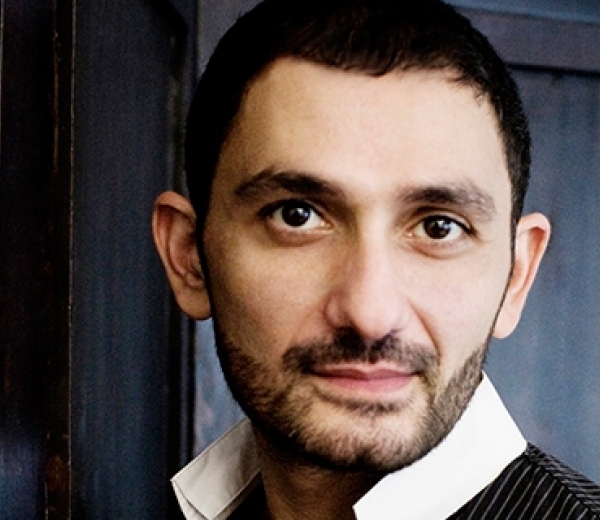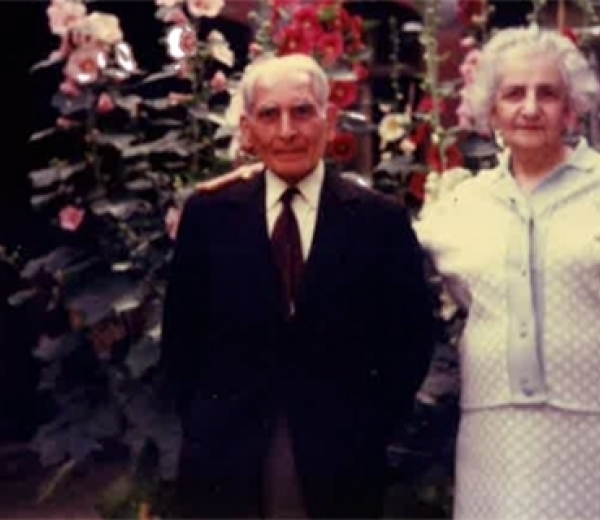Francis Kurkdjian
Submitted by global publisher on Wed, 08/26/2015 - 16:27
English
Intro:
Slim and graceful, dark-skinned and with a prominent nose, Francis Kurkdjian considers scents to be “ramparts of our humanity.” Born near Paris in 1969, he has no ties to the French capital of perfume Grasse, nor does he come from a family of perfume makers. Yet he has left a golden mark on the French world of aromas, having authored the “Green Tea” fragrance for Elizabeth Arden in 1999 and “My Burberry” for Burberry in 2014.
Weight:
-300
Story elements:
Text:
Always in search of a new fragrance, perfume maker Francis Kurkdjian treasures the memory of his maternal grandparents, who passed him the savors of a lost country.
Text:
Slim and graceful, dark-skinned and with a prominent nose, Francis Kurkdjian considers scents to be “ramparts of our humanity.” Born near Paris in 1969, he has no ties to the French capital of perfume Grasse, nor does he come from a family of perfume makers. Yet he has left a golden mark on the French world of aromas, having authored the “Green Tea” fragrance for Elizabeth Arden in 1999 and “My Burberry” for Burberry in 2014.
By age 46 Kurkdjian has created over a hundred perfumes, and his name now appears alongside big brands in luxury and beauty products. It was in his teens that Kurkdjian decided to make perfume, and at age 25 he composed his first work, “Le Mâle,” for the Maison Jean Paul Gaultier. Today, the global luxury industry pays court to his fragrances, and the company he co-founded in 2009 with Marc Chaya – Maison Francis Kurkdjian – continues to expand in France and around the world, particularly in the United States.
Image:

Text:
Cherchez la femme
Francis’s father Bedrosse Kurkdjian, born in 1936 to Antranig Kurkdjian and Nevarte Bartevian, is keeper of the family’s memory. He tells the story of his mother’s father Mihran Bartevian, a schoolteacher in the Pera neighborhood of Constantinople. “My grandfather was a sort of notable who taught the children of both well-off and modest families,” he says. It was a miracle that Mihran happened to be on the Princes Islands just off Istanbul at the time of the roundups of intellectuals in the Ottoman capital in April of 1915, thus escaping deportation.
Mihran’s son and Nevarte’s brother Ara Bartevian was also with him. Ara was the first in the family to settle in France in 1922. “My uncle was the family’s bridge to France,” Bedrosse continues. “There was a war, and so as not to be taken by the Turks he disguised himself as a woman to get on the boat without being noticed.” In France, Ara achieved a brilliant career as composer and conductor. He was also one of the first – in 1945 – to use vinyl discs to record secular and religious Armenian songs.
Roaming the globe
Antranig Kurkdjian, Bedrosse’s father, was born in 1895 in Bursa, in western Anatolia. Originally a tailor in furs, he frequently moved about. In 1922 he left for France, where his wife Nevarte joined him two years later. His first stop was Marseilles, then Lyons, where he became a silk worker before eventually going back to tailoring. Antranig and Nevarte had gone to a French school in Constantinople and they had no difficulty integrating in their new country. Antranig led the life of a globetrotter, and in 1941 even escaped the siege of Leningrad. Both Antranig and Nevarte, Francis’s paternal grandparents, died in 1975.
Image:

Text:
Antranig Kurkdjian with his daughter Emma, Francis's aunt.
Lives bought with coins
Francis’s mother’s family suffered a more disastrous fate. They were from Bandirma, a small town on the coast of the Marmara Sea. The Avedikian and Soghomonian families lived near the city’s Greek neighborhood. “They were a well-off family, sheep farmers and landowners – we still keep the deeds to the properties,” Francis says. His grandmother Saténig lost her father at an early age and was raised by her uncles and two aunts. The latter were all massacred in 1915, she and her mother being the sole survivors. “The men and women of Bandirma were all deported and quickly separated – the men were shot and the women piled onto cattle trucks,” Francis says.
Before deportation, however, Saténig and her mother had managed to sew gold coins in place of buttons on their clothes to bribe the Turks and Kurds brought in to kill them.
Thus they were deported to Konya in the south of Anatolia and were saved by the Red Cross Refugee Committee, which liberated their camp at the end of the war. But their return to Bandirma was short-lived – with the advance of the Kemal forces, they were again forced to flee.
“My grandmother Satenig had a good education,” Francis remembers. “Besides Armenian, she spoke fluent English, French, Greek, Italian and Turkish. When I was a child, she would always repeat that she had survived three wars: World War I, the 1919-1922 Greco-Turkish war and World War II. Besides all that, she survived the devastating Spanish flu of 1918.”
The father of Francis’s mother, Krikor Soghomonian, was born in 1891. He was a tailor by trade, which saved his life when he was deported in 1915. Forced to enlist in the Ottoman army to sew uniforms, he nevertheless managed to escape and return to Bandirma, where he found nothing but ruins. From there he took a boat to Genoa, then to Marseilles, then traveled to Vincennes where he finally settled, having joined a friend who found him work in a tailor shop. When he heard that his second cousin Satenig, 18 years younger, had survived, he brought her to France. They were married in Paris in 1934.
Image:

Text:
Krikor et Satenig Soghomonian, Francis’s maternal grandparents, in 1974.
Sylvia Florette – Francis’ mother – was born a year later in the 18th arrondissement of Paris. “When my grandfather Krikor died, my mother said, ‘He was an excellent father, but an impossible husband.’ My grandmother married him to bring her mother to France. She was not predestined to marry an artisan,” Francis says.
Kurkdjian, the Frenchman
Once a week Francis’ mother took a course in Armenian at the Armenian church in Paris, and with his parents Francis often went to community events – meetings of the Dachnak Party and commemorations of April 24, 1915. He remembers his immense respect for the charismatic figure of Chavarche Missakian, founder and chief editor of the legendary daily Haratch. “My grandfather received it every day, I went to get it from the mailbox. I remember him reading the obituaries. It was a way of finding the people he’d known in Bandirma, of keeping in touch with their world,” he recalled.
The Soghomonians recreated their world in Vincennes, an eastern suburb of Paris where a small Armenian community from Bandirma had settled. The door to their modest home was always open, the smell of coffee drifting through the air until late in the evening. “My grandmother held an open salon in Vincennes,” Francis remembers. “The five Armenian families living in Vincennes came to visit us all the time. They went from the home of one grandmother to the other, read coffee grounds and talked about their past lives in Armenia.
My grandparents nurtured a kind of flavor, a savor of the old country, but I never suffered from that nostalgia.
For me, they were evoking a magical country I couldn’t imagine because there were no photographs.”
Image:

Text:
Francis surrounded by his family: his brother Lionel, his sister Marina, his two nieces and his parents Sylvia and Bedrosse Mihran.
Satenig died at the age of 101. “It was she who instilled in us, besides love for our Armenian roots, the love of France and French culture, a feeling of gratitude to the country that had taken us in,” Francis says. “My grandmother was a very cultivated woman with an excellent memory and an open mind. She took us on visits to Parisian museums. One could say that she did everything in her power so that we wouldn’t grow up in a ghetto, even if she asked us to keep our Armenian roots.”
“Although we grew up with two cultures, I always had to justify myself when I pronounced my family name,” Francis recalls. Kurkdjian didn’t “Frenchify” his name, as did others before him. And while he would have liked to be a dancer with the French national opera, to live in the world of graceful movement, his passion for perfume won out in the end.
The story is verified by the 100 LIVES Research Team.
Subtitle:
French perfume maker on olfactory nostalgia
Story number:
138
Author:
Tigrane Yegavian
Header image:

